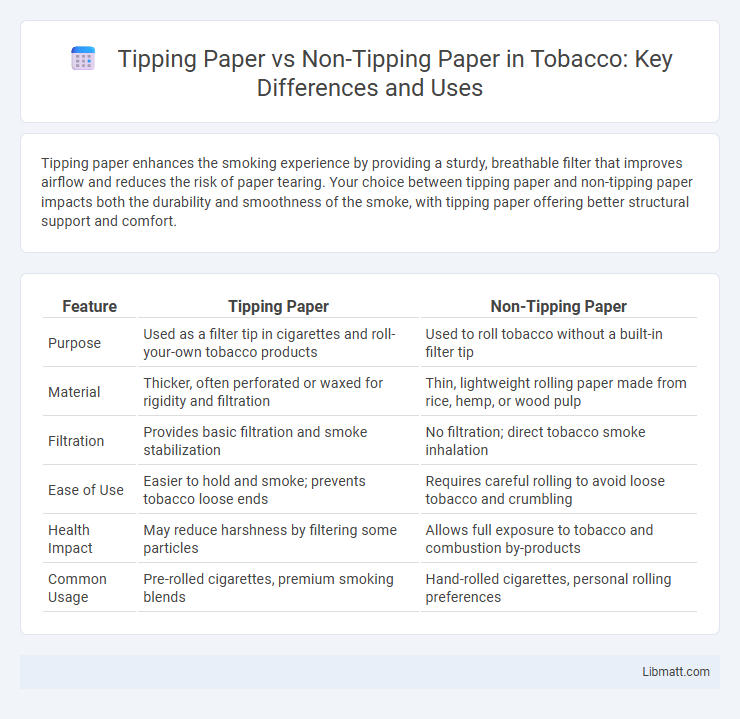Tipping paper enhances the smoking experience by providing a sturdy, breathable filter that improves airflow and reduces the risk of paper tearing. Your choice between tipping paper and non-tipping paper impacts both the durability and smoothness of the smoke, with tipping paper offering better structural support and comfort.
Table of Comparison
| Feature | Tipping Paper | Non-Tipping Paper |
|---|---|---|
| Purpose | Used as a filter tip in cigarettes and roll-your-own tobacco products | Used to roll tobacco without a built-in filter tip |
| Material | Thicker, often perforated or waxed for rigidity and filtration | Thin, lightweight rolling paper made from rice, hemp, or wood pulp |
| Filtration | Provides basic filtration and smoke stabilization | No filtration; direct tobacco smoke inhalation |
| Ease of Use | Easier to hold and smoke; prevents tobacco loose ends | Requires careful rolling to avoid loose tobacco and crumbling |
| Health Impact | May reduce harshness by filtering some particles | Allows full exposure to tobacco and combustion by-products |
| Common Usage | Pre-rolled cigarettes, premium smoking blends | Hand-rolled cigarettes, personal rolling preferences |
Introduction to Cigarette Paper Types
Cigarette papers primarily come in tipping and non-tipping varieties, each serving distinct purposes. Tipping papers act as a filter or mouthpiece area, enhancing your smoking experience by providing structure and easing handling. Non-tipping papers are simpler, used mainly for wrapping the tobacco and influencing burn rate and flavor.
What is Tipping Paper?
Tipping paper is a specially designed material used in cigarette manufacturing to attach the cigarette filter to the rolling paper, providing structural integrity and a secure bond. Non-tipping paper lacks this adhesive-coated section, making it unsuitable for securely joining the filter and paper, which can affect the cigarette's assembly and user experience. Tipping paper is typically made from a combination of cellulose fibers and adhesives optimized for heat resistance and durability during smoking.
What is Non-Tipping Paper?
Non-tipping paper is a specially designed, smooth paper used in cigarette manufacturing to attach the cigarette filter securely to the tobacco rod without visible adhesive or external gloss. Unlike tipping paper, which often has a printed or branded design and is slightly porous to allow airflow, non-tipping paper provides a seamless, uniform connection ensuring structural integrity and consistent smoking experience. It is essential for maintaining filter stability while preventing filter detachment and tobacco spillage during smoking.
Key Differences Between Tipping and Non-Tipping Paper
Tipping paper is specially designed for rolling cigarettes, featuring a porous texture that enhances airflow and adds structural integrity to the cigarette's filter end. Non-tipping paper lacks this porous quality and is typically used for rolling cigarettes without a filter, resulting in different burn rates and smoker experience. The key differences lie in their material composition, airflow properties, and specific applications in cigarette construction.
Materials and Composition
Tipping paper is typically made from lightweight, unbleached, and porous materials designed to improve airflow and allow smokers to hold cigarettes comfortably without burning their fingers. Non-tipping paper, on the other hand, often uses denser, more rigid cellulose fibers or bleached papers that provide a uniform burn but lack the ventilation properties of tipping paper. The composition differences impact both the burning characteristics and smoking experience, with tipping papers incorporating perforations or specific fiber blends to enhance breathability.
Functional Roles in Cigarette Construction
Tipping paper serves as the functional component that connects the cigarette filter to the rolling paper, ensuring structural integrity and a smooth handling experience. Non-tipping paper, typically the main rolling paper, encases the tobacco and influences burn rate and flavor delivery. Choosing the right combination of tipping and non-tipping paper can significantly affect Your cigarette's overall performance and smoking satisfaction.
Impact on Smoking Experience
Tipping paper significantly enhances the smoking experience by providing a stable and rigid mouthpiece that prevents tobacco or herbal material from entering the smoker's mouth, ensuring a smoother draw and better airflow. Non-tipping paper may cause discomfort as it lacks this structural support, often leading to uneven burning and harsher inhales due to the direct contact with rolling material. The choice between tipping and non-tipping paper directly influences the overall quality, taste, and enjoyment of the smoke.
Health and Safety Considerations
Tipping paper designed for smoking often incorporates heat-resistant materials to prevent harmful chemical release and ensure user safety, whereas non-tipping paper lacks this feature, raising risks of inhaling toxic substances from burning adhesives or fillers. Non-tipping paper may also combust unevenly, increasing the likelihood of inhaling irritants and causing respiratory irritation or potential long-term health issues. Selecting high-quality tipping paper with proper certifications reduces exposure to harmful additives, promoting safer smoking practices.
Industry Standards and Regulations
Industry standards for tipping paper in the tobacco and rolling paper markets specify precise material quality, thickness, and safety regulations to ensure consumer health and product consistency. Non-tipping paper often falls under different regulatory scrutiny since it lacks the perforated, adhesive-backed design typical of tipping papers, affecting compliance requirements such as flammability and chemical safety tests. Your choice between tipping and non-tipping paper should consider these regulatory distinctions to meet legal standards and ensure product reliability.
Choosing the Right Paper for Cigarette Production
Choosing the right paper for cigarette production hinges on the specific requirements of tipping paper versus non-tipping paper. Tipping paper is designed with heat-resistant properties and adhesive qualities to secure the filter to the cigarette, ensuring a smooth smoking experience. Non-tipping paper, typically used for the cigarette's main body, prioritizes burn rate and ash quality, influencing the overall smoking performance and flavor delivery.
tipping paper vs non-tipping paper Infographic

 libmatt.com
libmatt.com